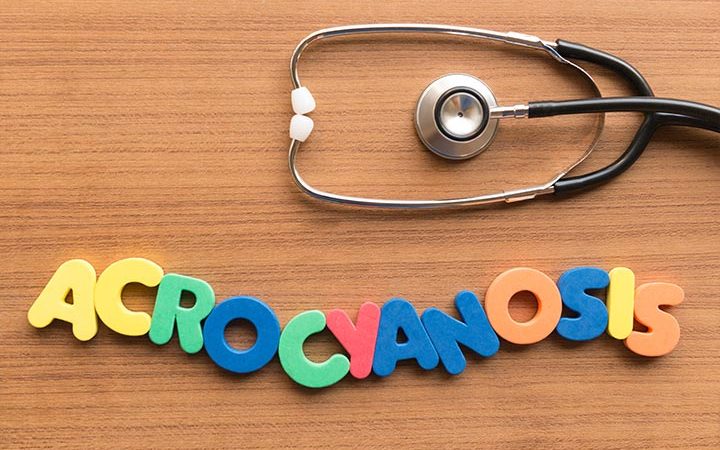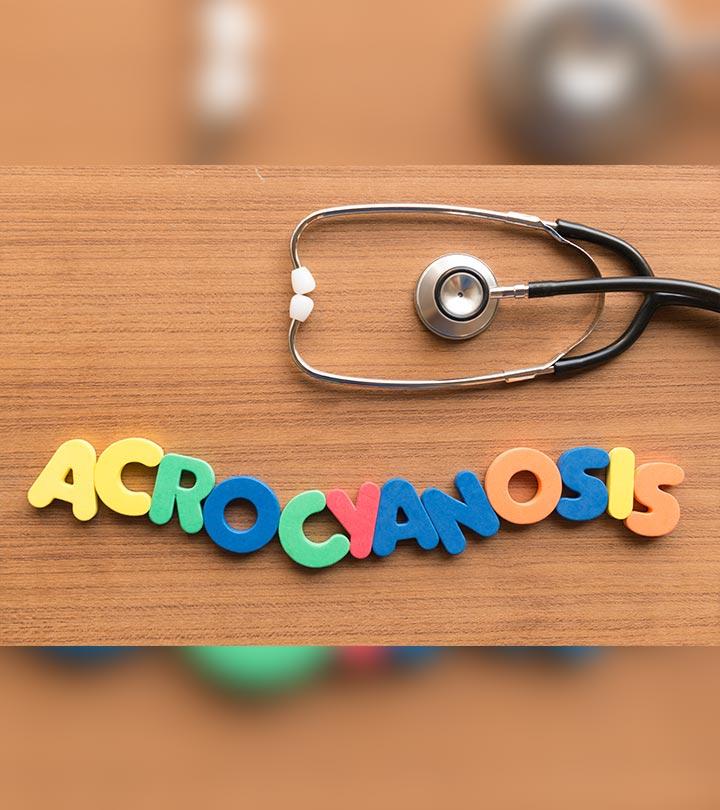Cyanosis means bluish-purple discoloration of the skin. Acrocyanosis refers to the cyanosis seen in the body’s extremities, especially in the palms and soles. It may also be seen around the lips. In most cases, acrocyanosis is normal in babies, as long as there is no cyanosis in the central part of the body.
Read this post to know more about the symptoms, causes, risk factors, diagnosis, and treatment of acrocyanosis in babies.
Symptoms Of Acrocyanosis In Babies
Painless bluish discoloration of hands and feet is the most notable sign of the condition. The following signs and symptoms may also be seen in acrocyanosis (1) (2).
- Affected areas may feel cold
- Bluish discoloration is symmetrically distributed
- Swelling in fingers
- Increased sweating
- Cyanosis may occur around the mouth
- Forearms, ears, lips, nose, or nipples may also be discolored in some cases
Causes Of Acrocyanosis In Babies
The causes of acrocyanosis depend on whether the acrocyanosis is primary or secondary (3).
1. Primary acrocyanosis
The exact cause of primary acrocyanosis is unknown. In newborns, a change in blood circulation could be the primary reason. Constriction of blood vessels that transport oxygen to the limbs may lead to acrocyanosis.
2. Secondary acrocyanosis
Secondary acrocyanosis usually happens due to an underlying condition and might be accompanied by pain in the discolored areas. It may be seen along with central acrocyanosis. It may happen in conjunction with one of the following conditions.
- Down syndrome
- Hypoxaemia
- Connective tissue diseases
- Neoplasms
- Peripheral vascular diseases
- Malnutrition
- Blood disorders
- Exposure to toxins
- Infections
- Mitochondrial diseases
- Ehlers-Danlos syndrome
- Buerger’s disease
- Spinal cord injury
Is It Normal For Newborns To Have Acrocyanosis?
It is normal for most newborns to have acrocyanosis for a few hours after birth (4). The reason is the new blood circulation pattern in the baby’s body. The blood and oxygen circulate to the vital organs, such as the brain, lungs, and kidneys, instead of hands and legs. Once the baby’s blood circulation adjusts itself, the acrocyanosis goes away. It might reappear when the baby is cold after a bath but goes away by itself soon.
Risk Factors For Acrocyanosis
The following risk factors may put the baby at a higher risk of developing acrocyanosis (1).
- Low body mass index (BMI)
- Sustained exposure to colder temperatures
- Presence of circulatory system-related problems that primarily affect blood vessels
- Girls are noted to have a slightly higher risk than boys
Diagnosis Of Acrocyanosis
Physical examination and a thorough medical history along with detailed symptom assessment are key contributors to the diagnosis of acrocyanosis. No pain with bluish discoloration is the main sign of acrocyanosis. If the doctors suspect secondary acrocyanosis, they will perform other tests and imaging.
Treatment For Acrocyanosis In Babies
In most cases, primary acrocyanosis does not need any treatment. Pharmacological intervention is not necessary most times. The baby should be kept warm to avoid acrocyanosis due to cold weather. Make sure to wrap the baby in a towel after a bath to prevent them from feeling cold.
Treatment of secondary acrocyanosis depends on the underlying cause and the symptoms. Secondary acrocyanosis resolves when the underlying condition is treated. Some conditions, such as genetic problems, may require long-term management to avoid secondary acrocyanosis.
Outlook For Babies With Acrocyanosis
Primary acrocyanosis is usually a harmless condition. In newborn babies, it usually resolves on its own and does not recur in most cases. Secondary acrocyanosis must be thoroughly investigated by the doctor, and the underlying condition must be addressed.
Acrocyanosis is normal in babies. Most cases of acrocyanosis in newborns resolve by themselves. If you notice any bluish-purple discoloration in your babies, bring it to the doctor’s attention. Keep your baby warm after birth to prevent primary acrocyanosis. Management of any underlying problems can help avoid secondary acrocyanosis.
References:
MomJunction’s articles are written after analyzing the research works of expert authors and institutions. Our references consist of resources established by authorities in their respective fields. You can learn more about the authenticity of the information we present in our editorial policy.



































